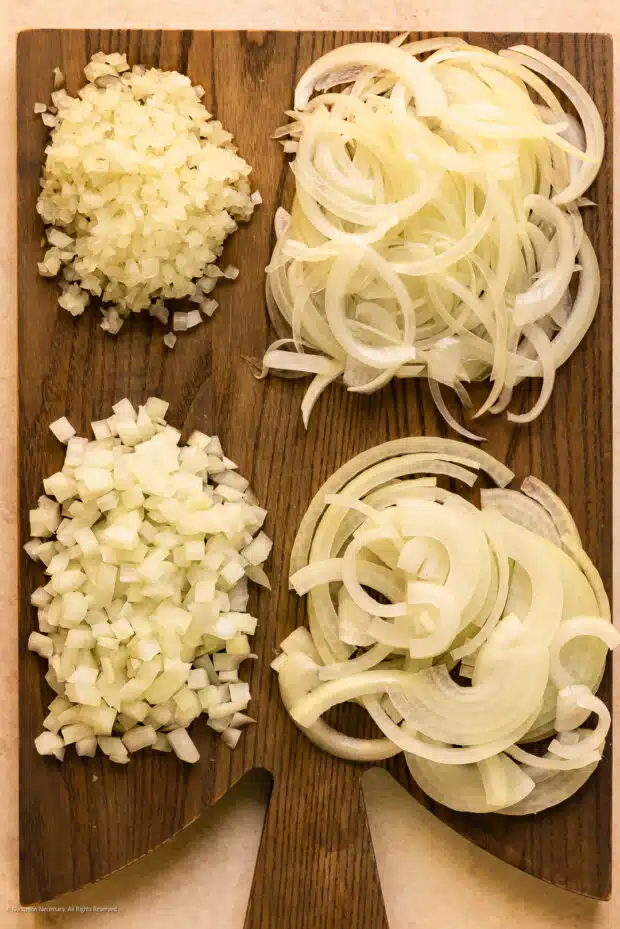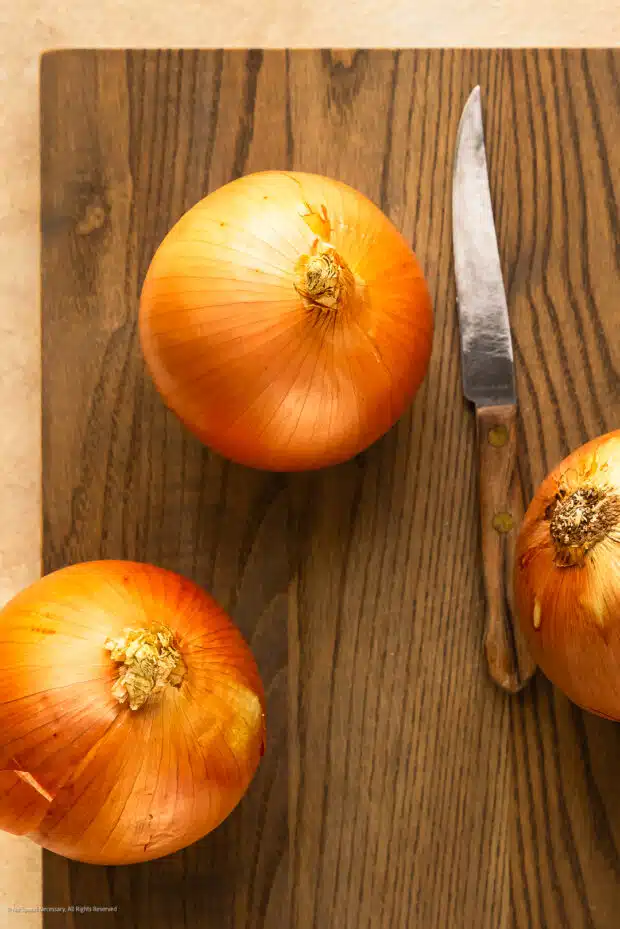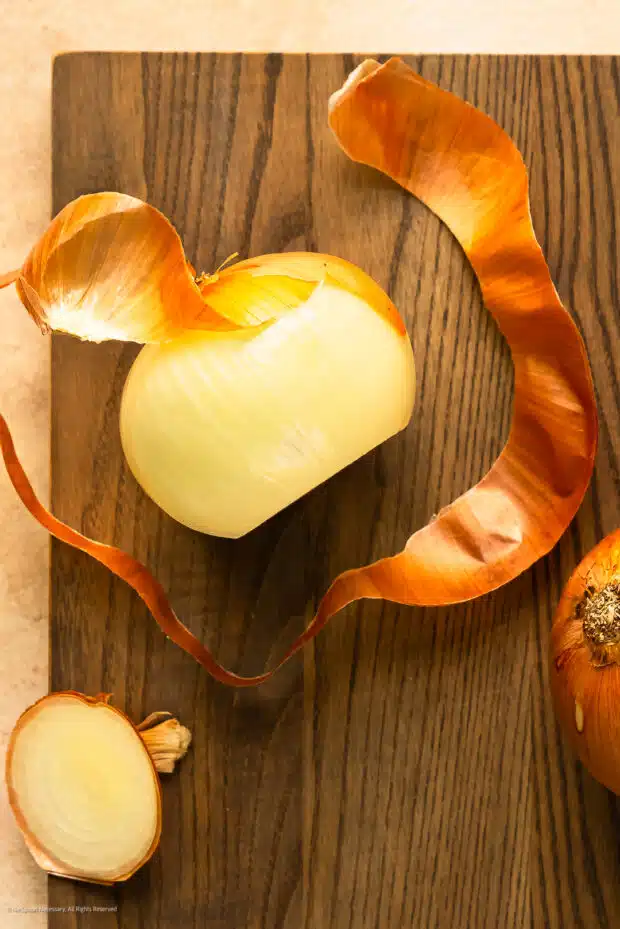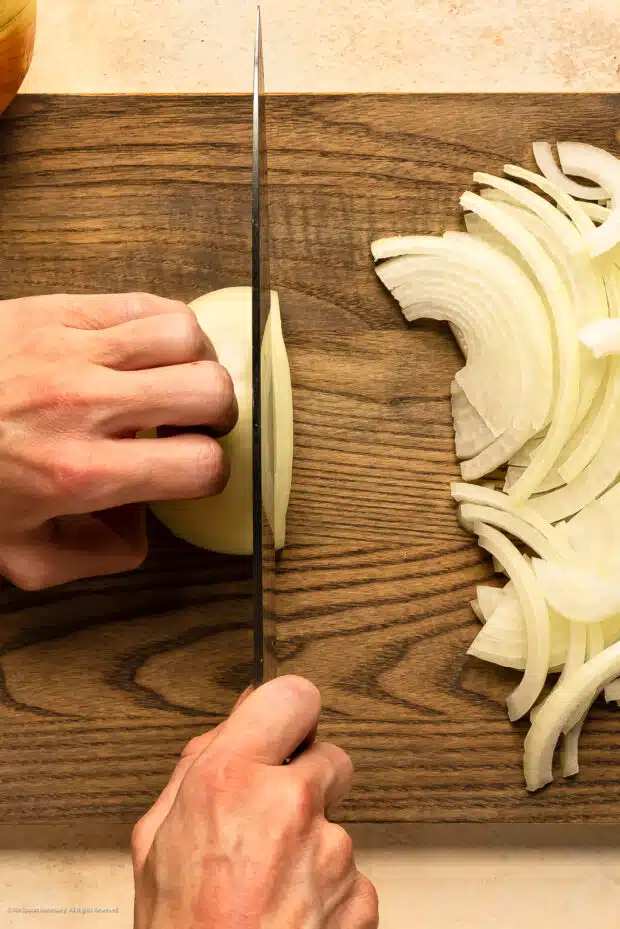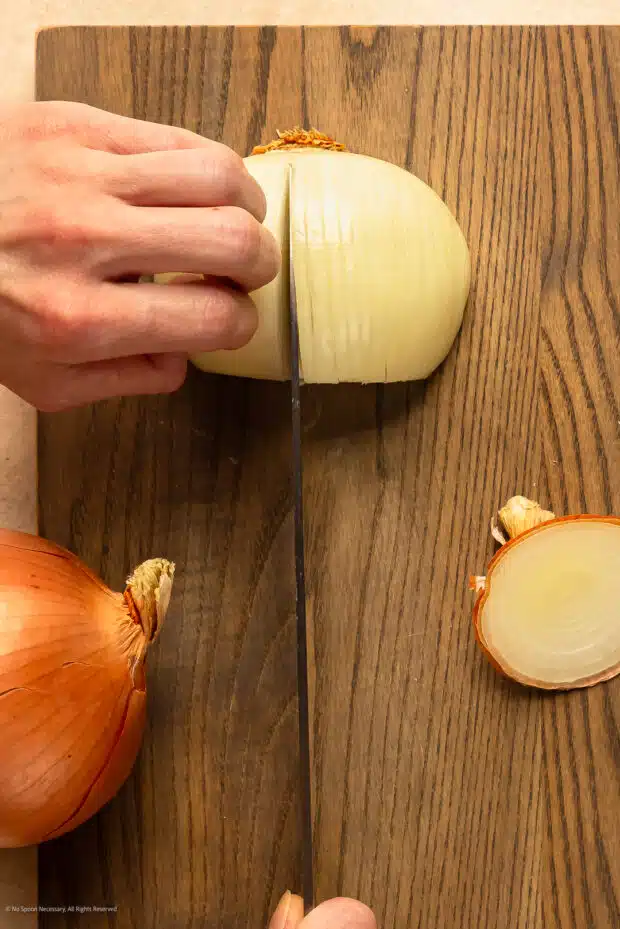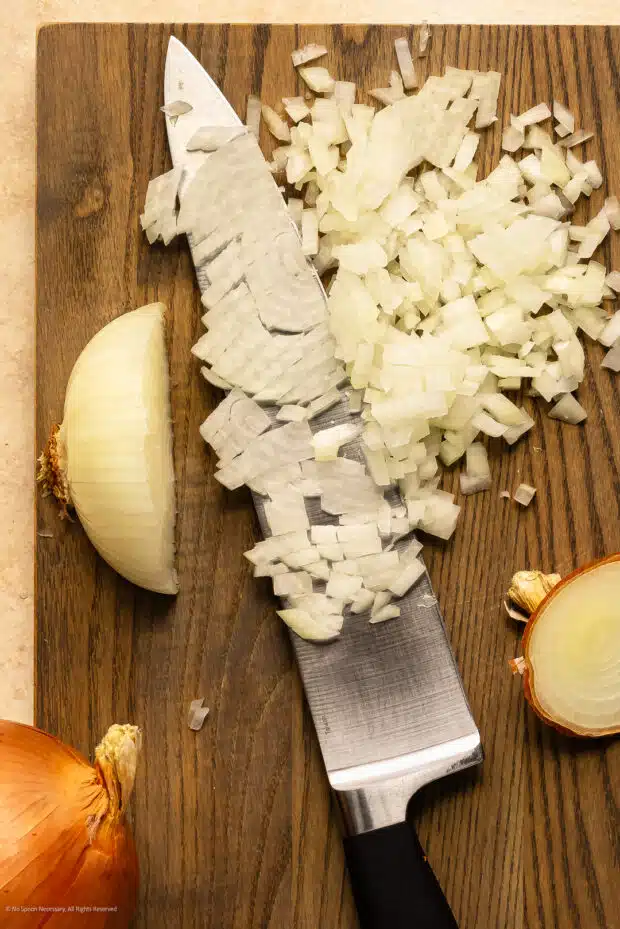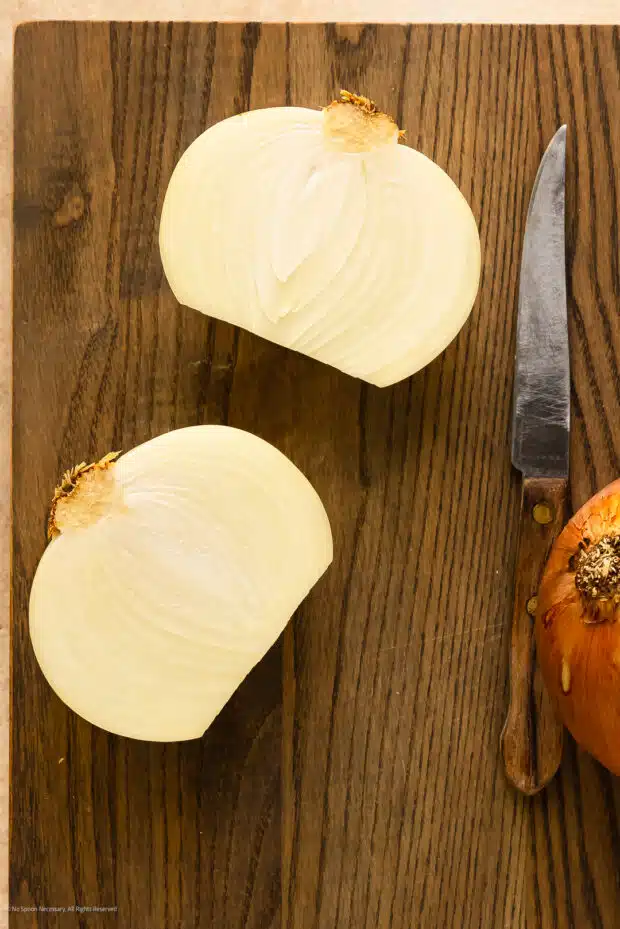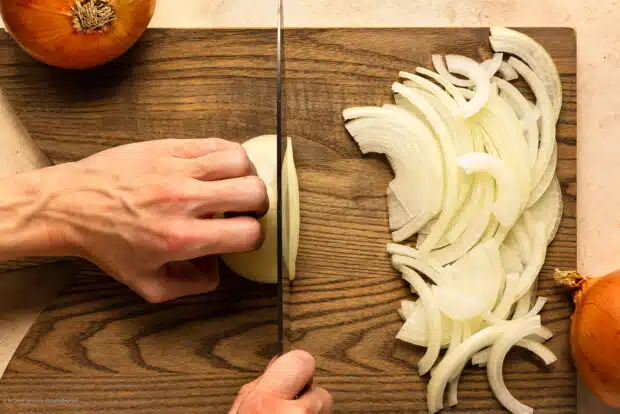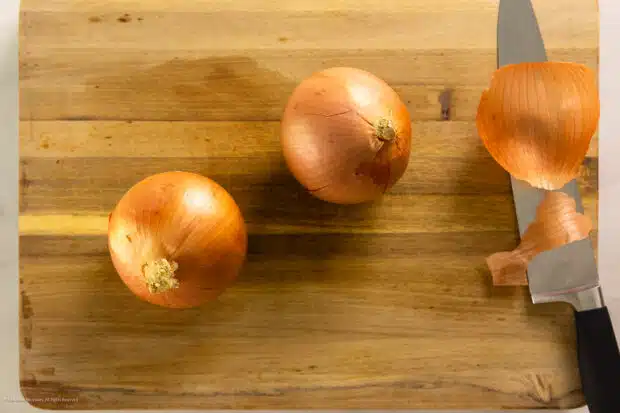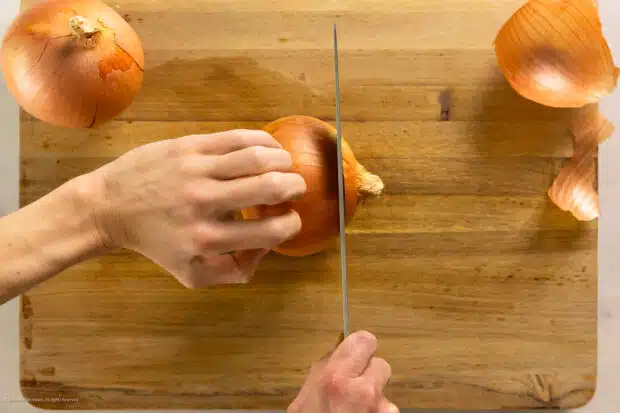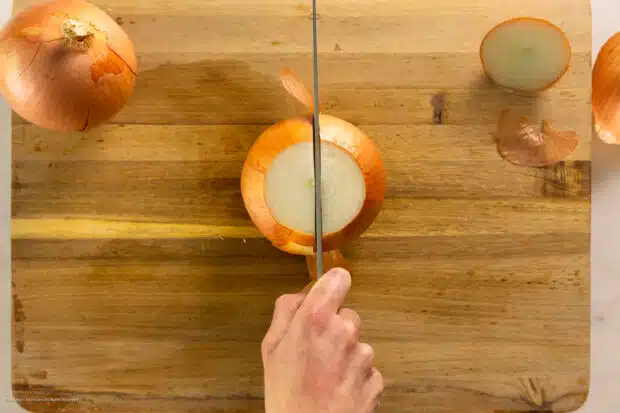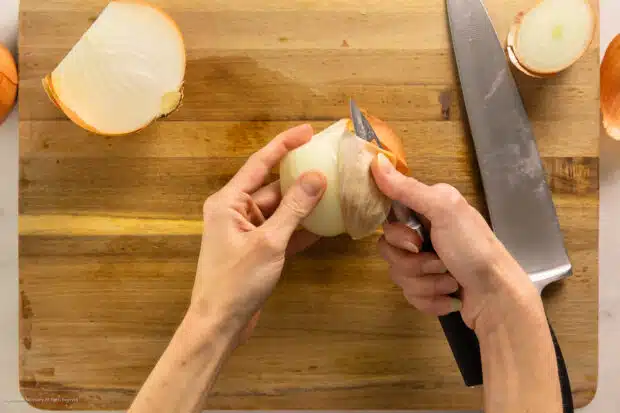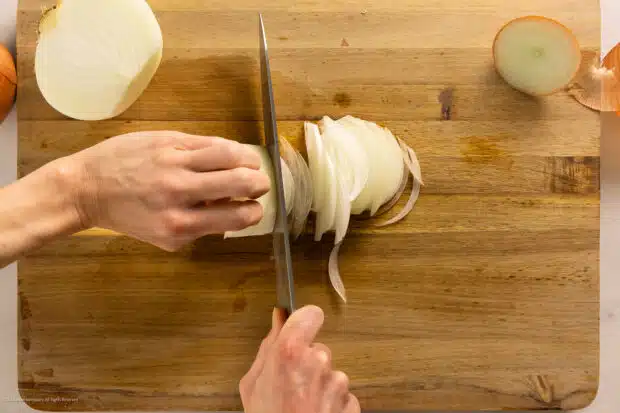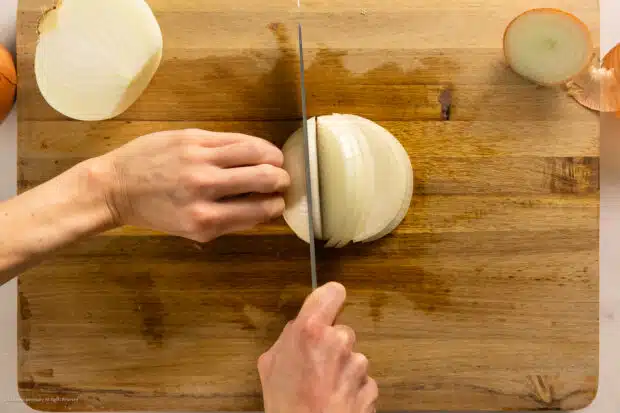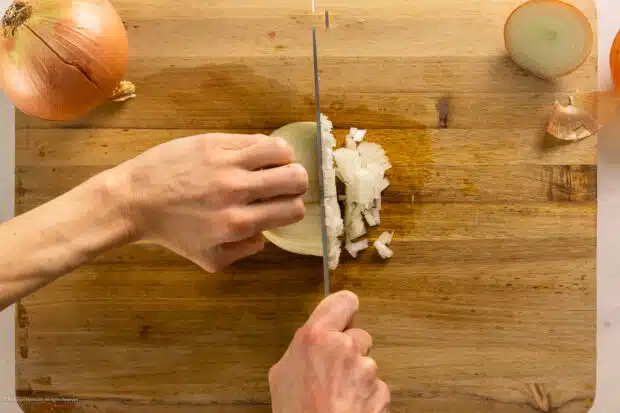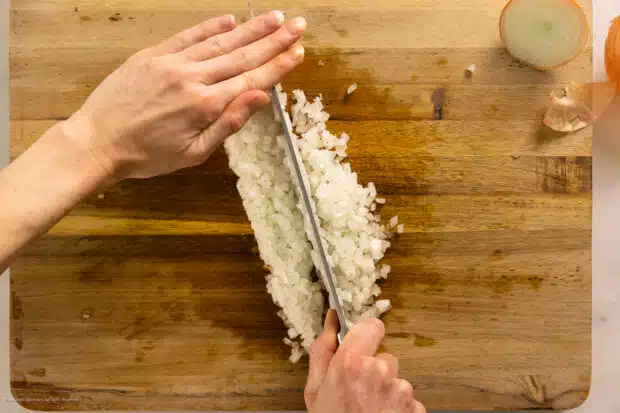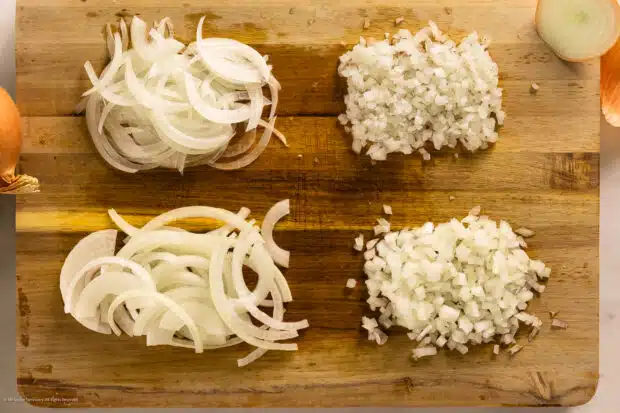This post may include affiliate links. Thank you for your support.
Do cutting onions make you cry? Don’t fret! In this guide, I’ll teach you How to Cut an Onion with a straightforward tutorial for slicing, dicing, and mincing onions. Put those silly kitchen goggles away and get all the details of cutting an onion the proper way, regardless of what you need it for!
Table of Contents
- Tutorial for cutting onion
- What’s an onion?
- What you’ll need to cut an onion
- How to prep a whole onion for cutting
- How to peel an onion
- To slice an onion into half moons
- How to julienne an onion
- How to dice an onion
- How to mince onions
- Expert tips for chopping onions
- How to use cut onions
- FAQs: onion slicing
- More culinary school kitchen tutorials!
- How to Chop an Onion Tutorial
Tutorial for cutting onion
If you’ve been wondering how to properly cut an onion, you’ve come to the right place! Today I’m discussing how to cut onions — the right way. Whether you need to chop, julienne, slice, dice, or mince a bulb onion, this step by step tutorial has got you covered.
What’s an onion?
An onion, also known as the common onion or bulb onion, is a round vegetable with many inside layers and an off-white, light brown, or magenta/purple skin. The onion comes from the genus Allium, which is one of the most widely cultivated species.
Fun fact: Up until 2011, the shallot and the onion were classified as separate species. Today, shallots are recognized as a botanical variety of the onion.
What you’ll need to cut an onion
- A sharp Chef’s knife
- Clean Cutting Board
- Onion (yellow onions, white onions, red onions, sweet vidalia onions, and/or shallots)
How to prep a whole onion for cutting
Let’s start by selecting a fresh onion. You’ll want to peel off and toss away any loose, papery layers from the outside. This exposes the good stuff inside!
How to peel an onion
After you’ve prepped your onions, you’ll want to peel them. Peeling an onion is pretty straightforward. However, there are two different ways you can remove the peel from an onion:
Method 1: Keep It Whole Place your onion on a clean cutting board. Grab a sharp kitchen knife and remove the stem (that’s the top part). Next, use a paring knife to grab hold of the outer layer of onion skin. Then, using the knife to assist you, peel the outer layer back and away from the onion.
Method 2: Halve It. Place your onion on a clean cutting board. Grab a sharp kitchen knife and remove the stem (again, that’s the top part). Next, slice the onion vertically, right through the middle of the root, but keep that root end intact. It’ll help wrangle the onions and keep them from sliding all over the place while you cut! Then, just use your fingers to remove the outer layer.
Expert tip: When peeling an onion, try to be gentle and take off as few layers as possible. Anything papery or rotten should go, but all the firm flesh should remain. Now, all that’s left to do is decide what shape you want your onions to be!
To slice an onion into half moons
This is the easiest onion knife skill, so we are going to start the tutorial with how to slice onions into half moons.
Working with one half of the onion at a time, arrange the onion so that the flat side is down, flush with the board. Next, look at the onion half and locate the lines running through it. The lines will look like lines of longitude on a globe – running from the root towards the tip of the onion. Now that you’ve located the lines, arrange your onion so that the lines are running parallel to you and the root is closest to your non-dominant hand – making the cut off tip of the onion closest to the knife. (Tip: If you are right-handed, the root should be on your left and vice versa for lefties.) Use your knife to cut through the onion – against the grain or lines – slicing as thick or thin as you prefer. Repeat the process with the other half of the onion until you have beautifully sliced half moons.
How to julienne an onion
Alright, now it’s time to bust out your real knife skills! Julienning, dicing, and mincing are slightly more advanced cutting techniques than slicing.
Working with one half of the onion at a time, arrange the onion so that the flat side is down, flush with the board. Use your knife to cut off and discard the stem (top) of the onion. Next, look at the onion half and locate the lines running through it. The lines will look like lines of longitude on a globe – running from the root towards the tip of the onion.
Now that you’ve located the lines, arrange your onion so that the lines are running perpendicular to you, and the root or stem side is closest to your body. Follow the lines of longitude, making 1/8-inch-wide cuts all the way through the onion. When you get to the top of the onion or the 90-degree mark, rotate the onion over and continue making 1/8-inch-wide julienne cuts all the way around the onion half. Repeat the process with the other half of the onion until you have beautiful julienne onion slices.
Tip: When julienning an onion, aim for slices that are even, thin, and about ⅛-inch wide.
How to dice an onion
Working with one half of the onion at a time, arrange the onion so that the flat side is down, flush with the board. Then arrange the onion so that the root is farthest away from you and the tip of your knife points towards the root.
Now look at the half of the onion and look for the lines running through the onion. The lines will look like lines of longitude on a globe, running north to south – from the root of the onion to the tip. Now that you’ve located the lines in the onion, make sure the lines are running perpendicular or towards you.
Then, use your sharp knife to make vertical slices through the onion, following the lines of longitude and the curve of the onion.
Once you’ve made the series of vertical cuts, rotate the onion 90-degrees so that the lines of longitude and your cuts are parallel to you. Use your hand to gently hold the layers of the onion together and then use your knife to make horizontal cuts through the layers of onion – crosswise to the first cuts you make.
And finally, say goodbye to the root; it goes in the trash. Repeat these steps with the other half of the onion until you have perfectly diced onions. The size of your dice depends on your recipe, so go small, medium, or large!
Tip: When dicing, try your best not to cut through the root unless your recipe demands it.
Note: Try to dice the onion as evenly as possible. The width of your cuts will depend upon the dice you’re after.
Dicing sizes
The size of your cuts should depend upon the dice you are after.
- For a small dice, your cuts need to be ¼-inch wide
- Medium dice, ½-inch wide cuts
- Large dice, ¾-inch wide cuts
- If a recipe calls for chopped onions, your dice should be roughly 1-inch around.
Dicing versus chopping
Many novice home cooks confuse chopping with dicing; however, they are not the same thing.
A chopping technique created chunks of food that are similar in size; however, not exact or uniform in shape. In addition, chopped ingredients should typically be about 1-inch in size, give or take.
Dicing, on the other hand, requires precision and exactness in size. A diced ingredient will be no larger than ¾-inch in size (large dice).
Why should you care? Firstly, the cooking times listed in recipes take into account the size of your ingredients. Cutting your ingredients properly ensures that every piece of food will cook evenly and through at the same time. Uniform cuts are also necessary if you’re looking for a restaurant-quality presentation.
How to mince onions
For a fine dice or mince, follow the steps for dicing an onion above. Then after dicing, hold your chef’s knife comfortably and put your free hand on top of the knife. Rock the knife back and forth over the pile of diced onions until they’re practically unrecognizable.
Every so often, use the heel of the knife (that’s when you rotate it so the blade is parallel to the cutting board, exposing the broad metal surface) to gather the onions back into a pile for easy mincing. Repeat these steps with the other half of the onion until you have minced onions.
Expert tips for chopping onions
- These onion cutting tricks work for any size or type of onion. Stop asking how to chop a red onion or how to dice a white onion — it works the same no matter the color!
- When using your knife to cut, slice, dice, and chop, make sure you tuck the fingertips of your non-dominant hand under to keep them protected and out of the way of your knife. This will also allow you to use your knuckles as a guide for the knife.
- When cutting, keep those lines parallel for a pro look.
- Store any leftover cut onion in an airtight container in the fridge for up to 10 days or in the freezer for up to a month. Just remember, freshly cut onions are the tastiest!
How to use cut onions
Now that you have learned how to peel and cut an onion into several different shapes and sizes, you’re ready to put that allium goodness to use in everything from meatballs and meatloaf to burgers, sandwiches, and more. Here are some of my fave onion-centric recipes to try:
Recipes using sliced onions
- Pickled onions
- Hot dog onions
- Mexican coleslaw
- Skirt steak fajitas
- Caramelize onions in the oven
- Sauteed onions and peppers
- Harissa chicken dinner
- Slow cooker steaks
- Caramelized Onions Tarts
Recipes using diced onions
- Pico Salsa
- Spicy Mango Salsa
- Chopped BLT Salad
- Best Tuna Macaroni Salad
- Herb potato salad without mayonnaise
- Zucchini and rice
- Thai peanut chicken
- Chinese steak and onions
- Cinnamon pork chops with apples and onions
FAQs: onion slicing
Why do onions make you cry?
When you cut into an onion, an enzyme known as alliinas is released into the air. This enzyme reacts with a sulfur compound in the onion to produce a volatile gas called propanethial S-oxide. When this gas comes into contact with your eyes it reacts and forms sulfuric acid, an irritant that will cause your eyes to tear up and burn.
As a former line chef who’s peeled, diced, and sliced a million onions, I can tell you that even if you try ALL the tricks in the book, you still may cry a little when you cut onions. However, with a little patience and practice, you can drastically reduce your tears!
How can I cut an onion without crying?
Sensitive eyes? There’s a few tricks to cutting an onion without releasing those educing enzymes:
- Chill your onions: Toss your onion in the freezer for about 10-15 minutes before cutting, or if you have more prep time, refrigerate it for 24 hours. While onions prefer to be stored at a cool room temp, cooling them further helps to prevent the noxious fumes that cause your eyes to water from spreading quite so far.
- Leave the stem intact: While I’m not fully convinced this trick is fool-proof, leaving the onion stem intact while chopping does help a little.
- Cool your eyes: I came up with this method on my own while working in a high end steak house restaurant and prepping 100s of onions for various dishes, like french onion soup and onion confit. Every single time my eyes teared up I ran into the walk-in cooler or freezer until my eyeballs felt better (usually a few seconds). While you may not have a walk-in cooler available, sticking your head in the freezer for a few seconds helps a little.
- Use a sharp Chef’s knife: The sharper your kitchen knife the less damage you will do to the onion skin, which also means the less sulfuric compounds being released into the air.
- Other methods I’ve tried: There’s all sorts of other humdrum “tricks” out there for chopping onions without crying, such as chewing a piece of gum or bread while chopping onions (ineffective), or actually cutting onions under running water (dangerous!); however, I did not find those methods remotely effective in the slightest of bits. But feel free to try them and let me know in the comments section!
Also, while I don’t think you really *need* onion goggles, my friends with glasses tell me it helps, but only a little. 🤷🏼♀️
Can you cut an onion in half and plant it?
Actually, as long as the root end is intact, you can in fact replant it. I’ve had only mild success with this trick (of the 10 or so I’ve tried to plant, only about 2 started growing), but it’s definitely worth a try if you have the space!
Remember, when it comes to onions, I’m all about those ‘layers’ of flavor! Happy slicing, dicing, and mincing, and may your culinary adventures always be ‘onion-point’
Cheyanne
Craving MORE? Follow all the deliciousness on Facebook, Pinterest and Instagram!
More culinary school kitchen tutorials!
- How to peel a peach
- Best Ways to Store Fresh Herbs
- 3 Ways to Grill Corn on the Cob
- How to Cut Broccoli
- Garlic Cutting Tutorial
- Knife Skills (how to cut vegetables)
- Riced Broccoli Recipe
How to chop onions at home 👇
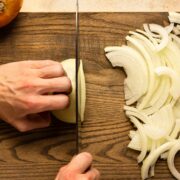
How to Chop an Onion Tutorial
Equipment
- 1 Sharp Chef’s Knife
- 1 Clean Cutting Board
Ingredients
- 1 whole Onion (any color)
Instructions
- Prep onion: Peel off and discard any loose outer papery layers of the onion.
- Remove stem: Place the onion on a clean cutting board and use a sharp Chef's knife to cut off and discard the stem end (top) of the onion.
- Cut the onion in half: Next, cut the onion in half vertically, through the middle of the root – so a portion of the root is intact on both halves of the onion. (Tip: Do not stand the onion up on the flat side and cut down into the onion through the root. Doing this pushes all the dirt from the root INTO the onion.)
- Peel onion: Use your fingers or a paring knife to peel off and discard the outer layer of the onion. (Tip: When peeling onions, you want to remove as few layers as possible.)
- To Julienne Onion: Working with one half of the onion at a time, arrange the onion so that the flat side is down, flush with the board. Use your knife to cut off and discard the stem (top) and the root (bottom) of the onion. Next, look at the onion half and locate the lines running through it. The lines will look like lines of longitude on a globe – running from the root towards the tip of the onion. Now that you’ve located the lines, arrange your onion so that the lines are running perpendicular to, or towards you, and one of the cut sides is closest to your body. Following the lines of longitude, make 1/8-inch-wide cuts all the way through the onion. When you get to the top of the onion or the 90-degree mark, rotate the onion over so that the cut side is flush with the board again. Then, continue making 1/8-inch-wide julienne cuts all the way around the onion. Repeat the process with the other half of the onion until completely sliced.
- To Slice Onion into Half Moons: Working with one half of the onion at a time, arrange the onion so that the flat side is down, flush with the board. Next, look at the onion half and locate the lines running through it. The lines will look like lines of longitude on a globe – running from the root towards the tip of the onion. Now that you’ve located the lines, arrange your onion so that the lines are running parallel to you and the root is closest to your non-dominant hand – making the cut off tip of the onion closest to the knife. (Tip: if you are right-handed, the root should be on your left and vice versa for lefties.) Use your knife to cut through the onion – against the grain or lines – slicing as thick or thin as you prefer. Repeat the process with the other half of the onion until completely sliced.
- To Dice or Chop an Onion: Working with one half of the onion at a time, arrange the onion so that the flat side is down, flush with the board. Then arrange the onion so that the root is farthest away from you and the tip of your knife points towards the root. Now look at the half of onion and look for the lines running through the onion. The lines will look like lines of longitude on a globe, running north to south – from the root of the onion to the tip. Now that you’ve located the lines in the onion, make sure the lines are running perpendicular to, or towards you. Then, use your sharp knife to make vertical slices through the onion - up to the root but not through it - following the lines of longitude and the curve of the onion. Once you’ve made the series of vertical cuts, rotate the onion 90-degrees so that the lines of longitude and your cuts are now parallel to you (the lines should run left to right). Use your hand to gently hold the layers of the onion together and then use your knife to make horizontal cuts through the layers of onion – crosswise to, or through, the first cuts you make. Once all the cuts are made, cut off and discard the root. Repeat the process with the other half of the onion until completely diced. (Note: Try to dice the onion as evenly as possible. The width of your cuts will depend upon the dice you’re after. Small dice = ¼-inch. Medium dice = ½-inch. Large dice = ¾-inch. Chop = roughly 1 inch)
- To Mince Onion: Follow the steps above for small dicing an onion. Once you’ve diced all the onion and discarded the root, arrange the chef’s knife so it’s fits comfortably in your hand. Place your free hand on top of the knife and then rock the knife back and forth repeatedly over the pile of onions to mince them until unrecognizable. Occasionally, use the heel of the knife to gather the onions back into a pile for easy mincing. Repeat the process with the other half of the onion until completely minced.(Note: Mincing is to make something virtually unrecognizable, it’s a much smaller cut than a “fine dice”)
- Use or Store: Use or store the cut onions in an airtight container and store in the refrigerator to use at a later date.
Notes
- Onions: This onion cutting tutorial works for any size, variety, and number of onions.
- Technique: When using your knife to cut, slice, dice, and chop, make sure you tuck the fingers of your non-dominant hand under to keep them protected and out of the way of your knife. This will also allow you to use your knuckles as a guide for the knife.
- Dicing sizes: When cutting onions, make sure you are aiming for evenly spaced, parallel lines. When dicing, make sure you space your cuts according to the dice you are looking to achieve.
- Fine Mince: 1/8-inch
- Small Dice: ¼-inch
- Medium Dice: ½-inch
- Large Dice: ¾-inch
- Chop: rough 1-inch dice (no need to be approximate)
- Storage: Place any sliced, diced, chopped, or minced onions into an airtight storage container. Store in the fridge for up to 10 days.
- Flavor Note: While you can prep onions in advance, please note that they have the most flavor when freshly diced, chopped, sliced, or minced. Onions will lose flavor during storage.
Nutrition
Did you make this recipe?
Mention @nospoonnecessary on Instagram and tag it #nospoonnecessary!
©No Spoon Necessary. All images and content are under copyright protection. Please do not use any images without prior permission. Kindly do not republish this recipe without prior consent. If you want to reference this recipe, please do so by linking directly to this post.

